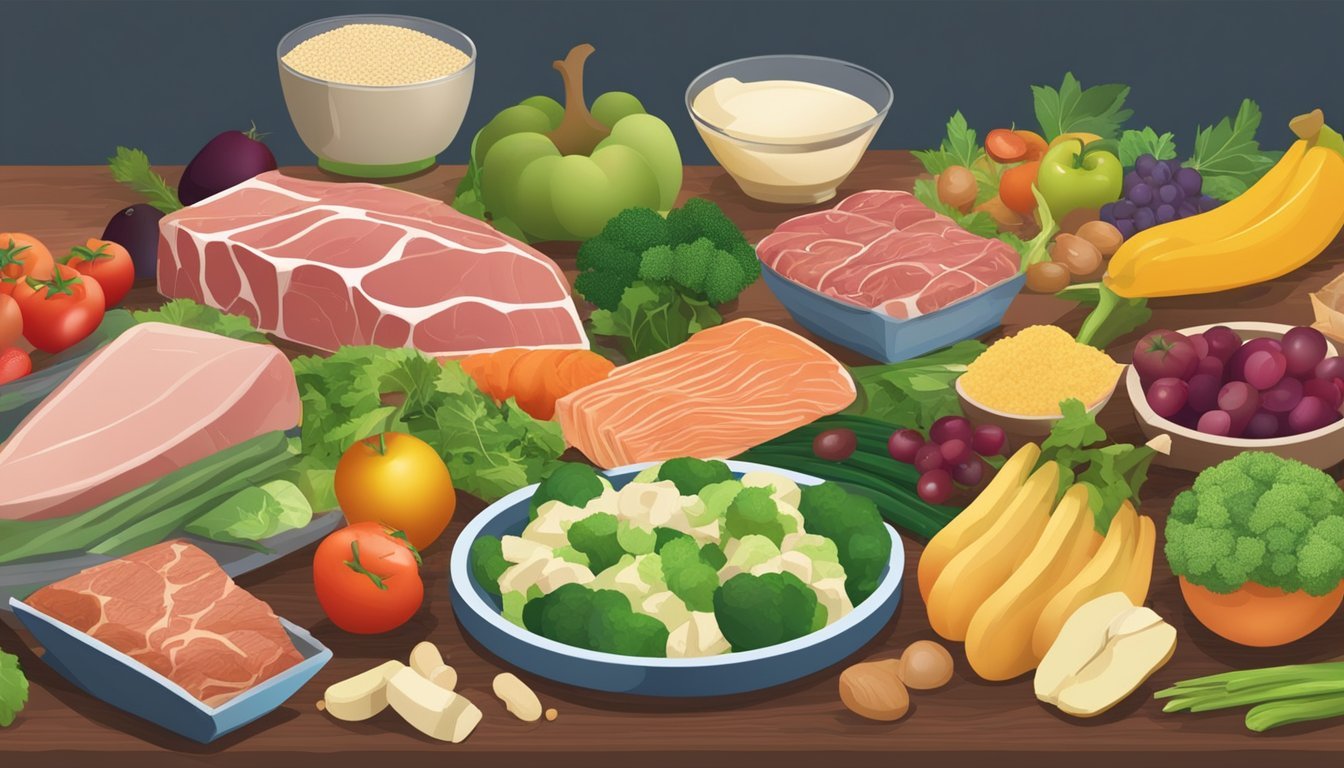Transitioning from Vegan to Paleo
A Guide to Dietary Change
Transitioning from a vegan diet to a paleo diet represents a significant shift in one's approach to eating. While the vegan diet excludes all animal products, focusing on a plant-based assemblage of fruits, vegetables, grains, nuts (What wine goes well with nuts?), and seeds, the paleo diet calls for a return to what proponents consider the eating habits of our Paleolithic ancestors. This includes a high intake of lean meats, fish, fruits, vegetables, nuts, and seeds, while eschewing processed foods, grains, legumes, and dairy.
Individuals may consider this dietary transition for a variety of reasons, such as personal health goals, nutritional needs, or curiosity about the perceived benefits of paleo eating. However, it's important to approach this change thoughtfully as the body needs time to adapt to new types of foods, specifically the introduction of animal proteins after a period of abstention. Careful planning can ensure the transition supports the individual’s dietary requirements and preferences without compromising nutrition or well-being.
As someone exploring a move from veganism to a paleo diet, they must be mindful of the challenges, which may include identifying paleo-friendly alternatives that align with their tastes and nutritional needs. Understanding the fundamentals of both dietary patterns will be integral to creating a balanced, fulfilling eating plan that acknowledges the core principles of paleo while respecting the journey from a previously plant-exclusive lifestyle.
Understanding Paleo and Vegan Diets
Transitioning between the vegan and paleo diets involves understanding the foundational principles and nutritional components of each. Both diets have distinct food profiles and health benefits when followed correctly.
Fundamentals of a Vegan Diet
The vegan diet eliminates all animal products, focusing solely on plant-based foods. Key components of this diet include:
Vegetables and Fruits: Rich sources of vitamins, minerals, and fiber.
Legumes: Offer a plant-based protein essential for muscle and tissue repair.
Grains: Provide carbohydrates, fiber, and a variety of nutrients.
Nuts and Seeds: Good sources of healthy fats, protein, and nutrients like magnesium.
People choose a vegan diet for various reasons, including health, environmental concerns, and ethical considerations regarding animal welfare. Nutritionally, it emphasizes consuming a variety of plant-based foods to obtain all necessary nutrients.
Principles of a Paleo Diet
A paleo diet is inspired by the foods presumed to have been eaten during the Paleolithic era. Foundational foods include:
Meat and Fish: Grass-fed, wild-caught, and free-range options are prevalent.
Eggs: A staple source of protein and nutrients.
Vegetables and Fruits: Similar to the vegan diet, these are crucial for their micronutrients.
Nuts and Seeds: Again, shared with the vegan diet, but without peanuts, as they are classified as legumes.
The paleo diet excludes processed foods, legumes, grains, and dairy, aiming to mimic the nutritional patterns of our hunter-gatherer ancestors. It is often chosen for perceived health benefits such as improved digestion and weight management, thought to stem from its focus on whole foods and avoidance of processed items.
Preparing for the Transition
Transitioning from a vegan to a paleo diet requires careful consideration of your current eating habits, nutritional needs, and pantry preparations. This will help ensure a smooth change in diet and maintain balanced health.
Evaluating Current Dietary Habits
It's important to assess your current vegan diet to understand what changes are needed for a paleo transition. Identify the frequency and quantity of grains, beans, and legumes, as these are staples in vegan diets but are excluded from paleo. Evaluating your intake of veg, fiber, vitamins, and minerals provides a baseline for the transition.
Assessing Nutritional Needs
Transitioning to paleo means removing certain food groups and adding others. Ensure that you obtain sufficient protein, fat, and essential nutrients like iron and vitamin D which you may have previously acquired from fortified plant-based foods. Focus on incorporating paleo-friendly sources of these nutrients, such as nuts, seeds, avocado, and sweet potatoes.
Planning Your Paleo Pantry
Stocking your pantry with paleo-approved items makes it easier to stick to the diet. Here's a concise list to start with:
Fats and Oils:
Olive oil
Coconut oil
Protein Sources:
Free-range poultry
Nuts and Seeds:
Almonds
Chia seeds
Vegetables:
Leafy greens
Cruciferous options like broccoli and Brussels sprouts
Rotate between these options to maintain a varied and nutrient-dense diet.
Implementing the Paleo Diet
The transition to a Paleo diet involves careful introductions of Paleo-approved foods, addressing nutrient needs specific to your health, and understanding the variations of Paleo diets to customize your approach.
Introducing Paleo-approved Foods
Introducing Paleo-approved foods starts with incorporating lean meats, fish, and eggs into one’s diet—these should come from high-quality sources where possible, such as grass-fed meats or wild-caught fish. Vegetable intake remains critical; one should include a variety of colorful vegetables to ensure a broad intake of nutrients. Including fruits, with an emphasis on those lower in sugar, provides important vitamins while adhering to Paleo guidelines. Nuts and seeds serve as excellent sources of energy and healthy fats, though one should consume them in moderation due to their high calorie and fat content.
Meats: Beef, lamb, poultry
Seafood: Fish, shellfish (What wine goes well with shellfish?)
Eggs: Preferably free-range or organic
Vegetables: A diverse range, with limited starchy variants
Fruits: Focusing on berries and those low in sugar
Nuts: Almonds, walnuts, cashews (mindful of portion sizes)
Addressing Potential Nutrient Deficiencies
When shifting from a vegan diet to Paleo, one may encounter challenges in balancing macros and micros due to the removal of grains and legumes. A Paleo diet relies heavily on meat and eggs for protein, and vegetables and fruits for fiber. However, one must be vigilant about adequate fat intake from sources like avocados and olive oil, and ensuring a variety of foods to cover the spectrum of B vitamins and essential minerals. It's important to maintain a balance, being attentive to potential increases in cholesterol and saturated fat.
Protein: Prioritize high-quality meat and eggs.
Fat: Incorporate healthy fats like avocados and nuts.
B Vitamins: Ensure variety in meats, green leafy vegetables, and eggs.
Fiber: Focus on high-fiber fruits and vegetables.
Carbohydrates: Get carbs primarily from vegetables and some fruit.
Understanding Paleo Variations
The Paleo diet has variations, including the "pegan" or Paleo vegan approach that combines principles from both diets. The Pegan diet focuses heavily on fruits, vegetables, nuts, and seeds while excluding dairy and limiting meat intake to a complementary role. Individuals following this approach must pay close attention to the balance of nutrition, ensuring that energy needs are met while maintaining health and vitality without excluding any crucial nutrients.
Vegan Paleo (Pegan): Emphasizes vegetables, fruits, nuts, and seeds.
Paleo Vegan: A variation focused on plant-based Paleo options.
Dairy: Generally excluded in Paleo variations.
Grains and Legumes: Avoided to comply with Paleo principles.
Managing Health and Wellness
When transitioning from a vegan to a paleo diet, individuals should closely monitor their health and wellness, making adjustments based on their body's response to dietary changes, to maintain a balance in weight, energy levels, and ensure long-term sustainability.
Monitoring Health Changes
Nutrition: Consider the range of micronutrients in both diets. A paleo diet often increases intake of proteins and fats but may lower fiber intake, which is crucial for heart health and blood sugar regulation.
Key Vitamins and Minerals: Ensure adequate levels of vitamin B12, iron, and calcium, commonly derived from animal products in paleo diets, which are vital for overall health.
Digestive Health: Track bowel movement regularity and gut comfort; both may be affected during the dietary transition.
Balancing Weight and Energy Levels
Weight Management: The paleo diet's emphasis on proteins and fats can lead to an initial phase of weight loss, but it is essential to balance macronutrients for sustained energy and health.
Balanced Macronutrients: Aim for a mix of fats, proteins, and low-glycemic carbohydrates to maintain blood sugar levels and provide energy throughout the day.
Regular Meals: To prevent energy dips, consume smaller, more frequent meals that align with paleo guidelines.
Considering Long-Term Sustainability
Chronic Disease Prevention: A balanced paleo diet can reduce risks of chronic diseases like diabetes and certain cancers by eliminating highly processed foods.
Dietary Variety: Include a wide range of vegetables, lean meats, and healthy fats to maintain nutritional balance and support long-term adherence to the diet.
Lifestyle Factors: Incorporate other healthy habits such as regular exercise, adequate sleep, and stress management which contribute to the overall success of the diet.
Lifestyle and Environmental Impacts
The transition from a vegan to a paleo diet encompasses not only a personal health journey but also reflects one's environmental ethos and sustainability values. This shift involves direct implications on land use, greenhouse gas emissions, and the ethical framework surrounding dietary choices.
Ethical Considerations of Diet Choices
A vegan diet abstains from all animal products, highlighting a lifestyle committed to reducing harm to animals and often citing environmental stewardship as a core reason. The fundamental change to a paleo diet, which incorporates grass-fed meats and eliminates grains and legumes, prompts a reevaluation of these ethical standpoints.
Environmental Impact: Vegan diets are typically associated with a lower environmental footprint, particularly in GHGe (greenhouse gas emissions) and land use, when compared to conventional diets that include animal products. However, supporters of the paleo diet argue that sustainably raised, grass-fed meat can have a lower environmental impact than industrial farming practices.
Diet Type GHGe Impact Land Use
Vegan Lower Lower
Paleo (with sustainably raised meat) Varies Higher
Health Benefits: In terms of health, the paleo diet's focus on whole foods is a boon, potentially offering improvements in nutrient intake when compared to a standard American diet. Yet, dismissing food groups integral to a vegan diet, such as whole grains and legumes, may eliminate valuable sources of fiber and certain vitamins.
Sustainability: The concept of sustainability on a paleo diet depends significantly on the sourcing of animal products. Sustainably raised, grass-fed animals can be part of an ecological cycle that promotes soil health and biodiversity, though it requires more land per calorie produced than plant-based options.
Sustainable Practices in Dietary Choices: Transitioning from a plant-based diet to a paleo framework also involves a shift in how one views the ethics and sustainability of consuming animal products. Individuals must consider human animal welfare, feed-to-food ratios, the use of antibiotics in livestock, and whether or not livestock is raised in a way that aligns with their ethical views on environmental conservation and animal welfare.
In summarizing the lifestyle and environmental impacts of transitioning from vegan to paleo, attention must be paid to the origin and production of food, ensuring that the chosen diet aligns with one's health objectives and environmental values.
Conclusion
Transitioning from a vegan lifestyle to a paleo diet represents a significant shift in nutritional intake and food sources. Those considering this change should approach it gradually, allowing their body to adapt to the inclusion of meats and a decrease in grain-based foods. It's crucial to consult with a nutritionist or a healthcare provider to ensure that the switch supports one's individual health needs and goals.
The paleo diet focuses on whole, unprocessed foods, much like a vegan diet; however, it emphasizes the consumption of animal proteins. Individuals may experience improvements in certain areas of health, such as blood sugar regulation and satiety levels. Nonetheless, they must ensure that they still receive a diverse range of nutrients. For example:
Omega-3 fatty acids from fish or grass-fed meat.
Fiber from non-starchy vegetables and fruits.
Vitamins and minerals from a colorful variety of produce.
Here's a simplified checklist to help guide the transition:
Task Description
Educate Yourself Learn about paleo-approved foods and those to avoid.
Plan Your Meals Create a balanced meal plan that slowly incorporates meat.
Monitor Health Indicators Keep an eye on digestive health and energy levels.
Seek Support Join paleo communities or forums for advice and motivation.
Remember, every individual's body responds differently to dietary changes, so what works for one person may not work for another. Careful monitoring and adjustments are paramount for ensuring a smooth and health-conscious transition.







